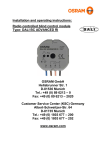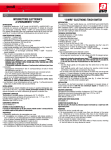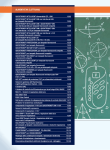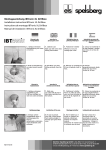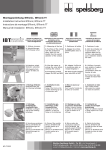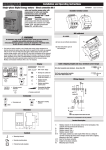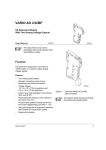Download Installation and operating instructions: Radio dimmer Type
Transcript
Installation and operating instructions: Radio dimmer Type: DALI DM ADVANCED LI OSRAM GmbH Hellabrunner Str. 1 D-81536 Munich Tel.: +49 (0) 89 6213 – 0 Fax: +49 (0) 89 6213 – 2020 Customer Service Center (KSC) Germany Albert-Schweitzer-Str. 64 D-81735 Munich Tel.: +49 (0) 1803 677 – 200 Fax: +49 (0) 1803 677 – 202 www.osram.com Contents 1. Function overview ....................................................... Page 3 2. Installation ................................................................... Page 4 3. Programming the radio transmitter.............................. Page 5 4. Deleting a radio transmitter ......................................... Page 6 5. Operation .................................................................... Page 6 6. Lighting scenes ........................................................... Page 7 7. Notes on radio operation............................................. Page 7 8. Technical data............................................................. Page 8 Page 2 Operating instructions: Universal Dimmer DALI DM ADVANCED LI 1. Function overview The universal dimmer enables a lighting system to be switched and dimmed by remote radio control. The power-on brightness level can be stored in the unit as a memory value. The unit is operated with a programmed transmitter (such as the hand-held transmitter). The transmitter can be used to switch the lighting system on or off (short press) or to fade the lighting level up or down (long press). The lighting system can also be switched on or off by means of a button directly on the unit. The universal dimmer can be programmed for up to 30 radio channels. The unit has a programming button c and a programming LED d. AC 230 V~ L 1 Prog ON/OFF dc Operating the universal dimmer in a system with a DALI central unit In systems with the OSRAM DALI RC ADVANCED unit, the equipment (such as control gear) is connected to the central unit via a control line. The DALI central unit receives the radio telegrams from the control units (such as the wall-mounted or hand-held transmitter) and reacts according to the programmed functions by sending control commands via the control line to the loads. If a radio-control universal dimmer is used in a system, it receives the transmitted radio telegrams from the control units in the same way as the DALI central unit and can react to them according to the programmed functions. As there are two separate systems, the channel or scene buttons of the transmitters which are to operate both the loads connected to the DALI central unit and the radio-controlled actuators (in this case the universal dimmer) must be separately programmed and deleted in the two systems. The universal dimmer is not a DALI unit; it cannot be operated or configured via the manual programming unit. Instead, it reacts only to radio telegrams from wall-mounted or hand-held transmitters, provided these have been previously programmed. Lighting scenes The universal dimmer can be incorporated in up to five lighting scenes. These are selected and stored with appropriate transmitters (wall-mounted or hand-held). First you must train the required lighting scene button in the universal dimmer. All ON/All OFF When a radio channel is programmed the ALL ON button and the ALL OFF button of this transmitter (e.g. hand-held transmitter) are also automatically programmed. When the ALL ON or ALL OFF button is pressed the lighting system connected to the universal dimmer is switched on or off. Note: The ALL ON and ALL OFF functions are protected against unintentional use by a delay circuit and must therefore be pressed for longer than a channel button or scene button. Operating instructions: Universal Dimmer DALI DM ADVANCED LI Page 3 2. Installation Important: Electrical equipment may only be installed by qualified electricians. Not suitable for disconnection. With the universal dimmer switched off, the load is not electrically disconnected from the mains. Always isolate when working on the load or on the unit. If the lighting system is operated with conventional transformers, each transformer must be fused on the primary side in accordance with the manufacturer's instructions. Only safety transformers that comply with DIN VDE 0551 may be used. If these safety instructions are disregarded there is a danger of fire etc. Installation Connect the universal dimmer as shown in the diagram. L N AC 230 V ~ 1 AC 230 V ~ L Recommended cable for effective cable clamp: H 05 VV-F 3X 1.5 Installation instructions • The distance from equipment that operates with high frequencies (such as microwave ovens, hi-fi systems and TVs) must be at least 0.5 m. • To avoid overloading the receiver (actuator), the distance between the universal dimmer and a transmitter must be at least 1 m. • You must comply with the technical connection conditions laid down by the electricity supplier. Ripple-control pulses from the electricity supplier may be noticeable as brief flickering at low dimmer settings. Automatic load detection After initial installation and after being isolated from the mains the universal dimmer detects the load automatically. Important: Do not connect capacitative loads (such as OSRAM Halotronic transformers) and inductive loads (conventional transformers) together to a universal dimmer. In the case of ohmic loads (incandescent lamps and high-voltage halogen lamps) the detection process is noticeable as brief flickering. Depending on the power supply, the detection process takes between 1 and 10 seconds. During this time, the universal dimmer cannot be operated. If a shortcircuit occurs during the detection process the load will have to be calibrated again when the shortcircuit has been removed. A power failure lasting more than 0.7 s will cause the universal dimmer to switch off. Page 4 Operating instructions: Universal Dimmer DALI DM ADVANCED LI Short-circuit protection Operation with trailing-edge phase dimming (capacitative loads, ohmic loads) Disconnection with automatic restart after removal of short-circuit within 7 seconds. After this time, the universal dimmer remains disconnected until it is switched on again manually. Operation with leading-edge phase dimming (inductive loads) Disconnection with automatic restart after removal of short-circuit within 100 ms. After this time, the universal dimmer remains disconnected until it is switched on again manually. Overtemperature protection If the ambient temperature is too high the universal dimmer will switch off automatically. When the ambient temperature has reduced, you have to switch the unit on again. 3. Programming the radio transmitter When a transmitter is being programmed, the sensitivity of the receiver is reduced to approx. 5 m. The distance between the universal dimmer and the transmitter to be programmed should therefore be 0.5 m to 5 m. Procedure 1. If necessary, switch off the lighting system connected to the universal dimmer by pressing the programming button briefly. 2. Hold down the programming button for about 4 seconds to switch to the programming mode. The LED will flash for about 1 minute. During this time a radio channel can be programmed. Prog 1 min t 3. Issue a radio telegram from the selected transmitter (wall-mounted or hand-held transmitter) by holding down a channel or lighting scene button until the LED lights up permanently to indicate that the universal dimmer has acknowledged storage. Prog 1 min t 4. You will automatic leave programming mode after about 1 minute, or you can briefly press the programming button (the load is switched on). The universal dimmer will then return to operating mode. Operating instructions: Universal Dimmer DALI DM ADVANCED LI Page 5 Notes • If all 30 storage locations are occupied you must delete a programmed transmitter before you can train a new one. • When a radio channel is programmed, the ALL ON button and the ALL OFF button (e.g. on the hand-held transmitter) are also automatically programmed. • All the programmed radio channels are retained in the event of a power failure. 4. Deleting a radio transmitter A programmed transmitter is deleted by starting a new training process for this transmitter (see "Training a radio transmitter"). All the channels and lighting scene buttons etc. must be deleted individually. Successful deletion is indicated by a rapidly flashing LED. Prog 1 min t It is best to keep a record of which transmitters (which channels) have been programmed in which actuators and enter this information in the documentation for the lighting system. Important for systems with radio actuators and DALI central unit: If you train/delete a lighting scene button in the universal dimmer that has already been programmed in the DALI central unit by means of the manual programming unit, the DALI central unit will also receive the radio telegram during the training/deletion process. In this case, the current lighting situation of the loads connected to the DALI central unit would be stored in the central unit as a lighting scene during the training/deletion process. To avoid this, you should select the lighting scene stored in the DALI central unit by pressing briefly on the appropriate scene button before you start the training/deletion process in the universal dimmer. 5. Operation A programmed transmitter (e.g. hand-held transmitter) can be used to switch the lighting system on or off (short press) or to fade the lighting level up or down (long press). A short press (approx. 1 s) on the programming button will alternately switch the load connected to the universal dimmer on and off. Memory function You can store a brightness value in the universal dimmer as a memory value. This value is used as the power-on brightness level. Storing a memory value 1. Set the lighting level to the required brightness. 2. Hold down the programming button for at least 4 seconds. By way of confirmation, a "soft start" takes place, in which the lighting is briefly switched off and then faded up to the memory value. Note: When the unit is shipped from the factory and after a power failure the memory value corresponds to the maximum brightness. Page 6 Operating instructions: Universal Dimmer DALI DM ADVANCED LI 6. Lighting scenes Before storing or selecting a lighting scene, you need to train a lighting scene button on the transmitter (e.g. hand-held transmitter) in the universal dimmer (see "Training a radio transmitter"). You can then store the data of a lighting scene (switching status or brightness of the lighting system) in the universal dimmer. You can change a lighting scene at any time by storing it again. Storing a lighting scene 1. Set the required brightness for the lighting system. 2. Hold down the lighting scene button on the transmitter for at least 3 seconds. The old lighting scene is first called up (this does not apply to loads connected to the DALI central unit); do not release the button. After about 3 seconds the new lighting scene is activated and stored. Important for systems with radio actuators and DALI central unit: If you use a lighting scene button that has already been programmed in the DALI central unit by means of the manual programming unit, the DALI central unit will react to the radio telegram during the storage process. In this case, the current lighting situation of the loads connected to the DALI central unit would be stored in the central unit as a lighting scene. This would overwrite a lighting scene that has already been stored. To avoid this, you should select the lighting scene stored in the DALI central unit by pressing briefly on the appropriate scene button before you start storing the lighting scene in the universal dimmer. 7. Notes on radio operation A non-exclusive transmission path is used for radio transmission, which means that interference cannot be ruled out. Radio transmission is not suitable for safety applications, such as emergency shutdown or calls to the emergency services. The range of a transmitter (up to 100 m in the open) depends on the nature of the building: Dry material Wood, plaster, plasterboard Brick, MDF Reinforced concrete Metal, metal grating, aluminium cladding Penetration approx. 90 % approx. 70 % approx. 30 % approx. 10 % Operating instructions: Universal Dimmer DALI DM ADVANCED LI Page 7 - This radio system may only be connected to other communication networks if this does not infringe the relevant national laws. - This radio system may not be used for communicating beyond property boundaries. - If used as specified, this device complies with the requirements of the R&TTE directive (1999/5/EU). A complete conformity declaration can be found on the internet at: www.osram.de 8. Technical data Power supply: AC 230 V 50/60 Hz (N conductor not required) Connected load: 50–315 W/VA 230 V incandescent lamps (ohmic load, trailing-edge phase dimming) HV halogen lamps (ohmic load, trailing-edge phase dimming) OSRAM Halotronic transformers (capacitative load, trailing-edge phase dimming) or Conventional transformers (inductive load, leading-edge phase dimming) Receiving frequency: 433.42 MHz, ASK Type of protection: IP 20 Dimensions (LxWxH): 187x28x28 mm Temperature range: approx. 0 to +55 °C Recommended cable for effective strain relief: H 05 VV-F 3X 1.5 We can guarantee proper operation only with OSRAM Halotronic transformers or with conventional iron-copper transformers. For mixed loads with conventional transformers, do not exceed a 50 % share for the ohmic load (incandescent lamps, HV halogen lamps). Do not mix capacitative loads with inductive loads. R,L,C The symbols used to identify dimmer loads indicate the type of load that can be connected to dimmers or the electrical behaviour of a load: R = ohmic, L = inductive, C = capacitative. Digital Addressable Lighting Interface The international digital interface standard for the lighting industry Date 13.09.02 / Universal Dimmer ADVANCED Version 1.0 Subject to change without notice. Errors and omission excepted. Page 8 Operating instructions: Universal Dimmer DALI DM ADVANCED LI








